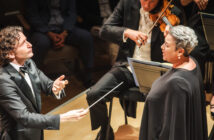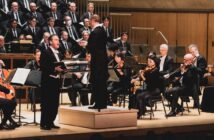by Paul E. Robinson
I must confess that I was reaching the point where I doubted I could sit through another performance of Carmen! The plot was too silly, the music overly familiar and the characters merely cardboard cutouts; then, along came the Royal Opera House production directed for the stage by Francesca Zambello, and for film by Julian Napier. Did I mention it was in 3D? This production of Carmen (poster: right) in 3D was a fantastic experience, and completely restored my faith in Bizet’s venerable opera. It also provoked me to question the Met’s pioneering efforts in streaming opera live in HD to movie theatres, and to wonder about how we might view opera ten years from now.
This production of Carmen (poster: right) in 3D was a fantastic experience, and completely restored my faith in Bizet’s venerable opera. It also provoked me to question the Met’s pioneering efforts in streaming opera live in HD to movie theatres, and to wonder about how we might view opera ten years from now.
Super-Tech-Saavy Opera Here at Last!
There is no question that film technology has taken giant strides in the last 20 years. Whatever one may think of the content of his films, James Cameron has worked wonders with the likes of Titanic and Avatar. The incomprehensibility of “Inception” shouldn’t obscure the fact that this is astonishing moviemaking.
Opera came late to the full scope of possibilities ushered in by new technologies: Lotfi Mansouri started experimenting with “surtitles” in Toronto in 1983, but powerful purists like Herbert von Karajan and James Levine delayed the introduction of this simple, unprecedented audience multiplier for years, if not decades, in major houses.
Just as significant was the possibility of giving millions of people a first-class operatic experience through streaming live performances into movie theatres; this breakthrough had to wait another 20 years, not because anyone opposed it, but because of production costs and the lack of good picture quality. With the advent of High Definition (HD) technology, the latter barrier was removed. Under Peter Gelb’s leadership, the Met has taken ownership of this medium and, on the whole, has used it well.
Within the last six weeks or so, I have seen three very different “Met Live in HD” productions – Puccini’s La Fanciulla del West, Adams’ Nixon in China and Gluck’s Iphigenie en Tauride.
I don’t much care for the music in the Adams opera – that nearly constant pulsing rhythm drives me crazy – nor do I find the libretto particularly insightful about the politics or the historical figures portrayed; overall, however, the performances of these three operas were excellent, and agreeably imaginative.
Faltering Production Values?
My caveats have to do with the work of the film crew, and the theatre in which I saw these performances. It seems to me that the team now filming the Met productions has either changed, or is becoming less thorough in its preparation – perhaps both; for example, in one of the “Fanciulla” intermission segments we had an extended interview with the folks who wrangled the horses, and then met all four horses to be featured in the next act. Exciting! Then back to the performance. I am sure I was not the only one watching for the horses! As far as I could tell, only one horse made an entrance. The stage was very dark and it appeared only briefly outside Minnie’s cabin. Perhaps all four horses did appear on stage and the director failed to capture them on camera! After that extended intermission feature on the horses, it seemed perverse, if not incompetent, not to give them their moment on stage! But, you say, who watches opera for horses anyway?
Let me give another example of what might be considered less than stellar work. In recent “Met Live in HD” productions, we have had live shots of cameras moving into position. Sloppy. I don’t recall this happening in earlier broadcasts.
As Goes the Theatre, so Goes the Show!
Compounding my disappointment was the persistent darkness which permeated the entire Fanciulla production. Nixon in China was just as bad.
I am now convinced that the projection in the movie theatre where I saw Fanciulla skewed the light values of the live production.
Over the past few years, I have seen quite a number of “Met Live in HD” showings in a variety of theatres in both the U.S. and Canada. More often than not, there has been a technical problem of one kind or another. Sometimes the streaming stopped altogether, and sometimes it had trouble starting.
On occasion, I have had to ask that the volume be turned up, and just as often that the volume be turned down. The sound quality is generally pretty good for voices, but for the orchestra, I have never heard it better than mediocre. Coincidentally perhaps, many made the same complaints about early acoustical recordings!
As if these challenges to this fabulous new way for people at large to enjoy live opera were not enough, in many theatres, the thumping cacophony from action movies being screened next door all but ruins the experience.
I have done my part to complain to management when such problems occur. I am often amazed that the other patrons just sit there and take it. No wonder it doesn’t get any better!
Perhaps most movie theatre patrons don’t realize that there is usually no projectionist in the theatre at all. In modern multiplexes one person – usually young and with limited training – sits in front of a bank of monitors displaying all eight or twelve movies being screened. As long as there is some kind of picture, this person probably thinks everything is fine. Since the “Met Live in HD” is featured infrequently and one may fairly suspect that the person in the display room knows little or nothing about opera, one may conclude that there is virtually no quality control during the streaming.
Royal Opera House, Covent Garden Carmen in 3D Now we come to the 3D Carmen (photo right: Christine Rice and Bryan Hymel) I saw last week. Again, there weren’t many people at my local theatre screening – would you believe two, in addition to my party of four? The paltry audience aside, this performance and the film experience were both extraordinary.
Now we come to the 3D Carmen (photo right: Christine Rice and Bryan Hymel) I saw last week. Again, there weren’t many people at my local theatre screening – would you believe two, in addition to my party of four? The paltry audience aside, this performance and the film experience were both extraordinary.
Unlike the “Met Live in HD” presentations, this was not a “streamed” performance “live” from an opera house – in this case, the Royal Opera House, Covent Garden. Although it was presented on screen as a live performance, my guess is that it was filmed partly “live” with an audience and partly without. The sound quality was simply too consistent and too good, and the camera placement made one wonder if this kind of intrusiveness would be attempted in front of a paying clientele.
As I understand it, the problem with the sound on “Met Live in HD” may be that the streaming technology requires serious compression with a major loss of dynamic range and presence. Since the 3D production from Covent Garden was projected in film form, rather than streaming, the compression problem was eliminated.
3D is not new. Years ago we all experienced the amazing special effects in films like House of Wax and Bwana Devil, both released in 1953. That technology didn’t seem to have a future in character-driven drama, and it seemed unlikely that patrons would put up with sitting through every new film wearing special plastic glasses.
Then came IMAX technology (1987), which provided the 3D experience without glasses. But again, IMAX and its wrap around screen has been reserved for subject matter that clearly benefits from it, such as space exploration and plane rides over mountains.
3D Tech Gives New Depth to Opera
Now we have a new generation of 3D technology that aims to be more than a short-lived curiosity. We still have to wear the glasses, but the picture quality is superior to anything that has come before. It is not just the depth of the picture that is startling, but the clarity. We simply see more than we have ever seen before in a film. In some scenes in this Covent Garden Carmen, we feel as if we are on stage with the singers, and we have a sound quality that surpasses anything I have heard from the “Met Live in HD” screenings. The Royal Opera House Orchestra is not the equal of the Met Orchestra, but it has a presence and a depth that sounds like an audio equivalent of 3D.
Lively, Imaginative Direction and Exciting, Unfamiliar Voices This Royal Opera House production didn’t have any big “stars” – perhaps that is why the audience was so small – but there wasn’t a weak link anywhere. With her exquisite voice and deft characterization, Latvian soprano and rapidly-rising Met star Maija Kovalevska (photo: right) almost stole the show as the simple country girl, Micaëla. Tenor Bryan Hymel (Don José) of New Orleans looked great and sang and acted with real stature. In the title role of Carmen, mezzo-soprano Christine Rice sang well and acted the part with strength and allure.
This Royal Opera House production didn’t have any big “stars” – perhaps that is why the audience was so small – but there wasn’t a weak link anywhere. With her exquisite voice and deft characterization, Latvian soprano and rapidly-rising Met star Maija Kovalevska (photo: right) almost stole the show as the simple country girl, Micaëla. Tenor Bryan Hymel (Don José) of New Orleans looked great and sang and acted with real stature. In the title role of Carmen, mezzo-soprano Christine Rice sang well and acted the part with strength and allure.
This production was not about “star” turns. It was a true “ensemble” effort, expertly prepared by director Francesca Zambello, who avoided most of the clichés, while keeping the action in familiar territory in terms of time and place.
Escamillo entered on horseback in Act 2, and in the last scene ‘s procession to the bullring, Carmen appeared atop an ornate carriage – both imaginative touches, well integrated into the drama. The fight scenes were elaborately choreographed and fast-paced. The dancers at Lillas Pastia’s tavern were exciting to watch and the smuggler’s quintet was brilliantly executed.
Conductor Constantinos Carydis also deserves a lot of credit for his work in this production. He had me on his side from the opening bars of the Prelude when he took a very moderate tempo, compared to the breakneck speed that seems to be the norm these days. The same music reappears for the procession in the final scene of the opera and is obviously intended to be played at a stately march tempo. Carydis also worked wonders with the chorus. The control of dynamics in Act 1 was extraordinary.
I thoroughly enjoyed this production of Carmen, and I don’t think I was simply being bamboozled by the novelty of 3D; that said, the 3D presentation certainly heightened my experience and I look forward to seeing more opera and concerts using this technology.
From Theatre to Home Entertainment Centre?
For the record, I must mention that while the 3D Carmen was a superior technical achievement, it was far from flawless. One major issue: for part of the performance, music and action were out of sync. There is no excuse for such a basic problem, when vast sums of money are being spent on the project and when the success or failure of 3D technology itself depends on putting out a quality product each time out of the gate.
Obviously, we live in an age when the technology for entertainment and cultural products is changing rapidly. The CD and DVD age is now just about over and the replacement is downloading and streaming. And who says we need a theatre? We already download all sorts of products from the internet. How difficult could it be to offer us “Met Live in HD” on our TV sets at home? Surely that is coming soon. As for opera in 3D, that too will soon be available for enjoyment at our home entertainment centres – all of it sent to us wirelessly!
Whatever the distribution method – big screen or home TV – the product must be worth the price. Not only the opera or concert performance, but also the technology must be excellent. In a competitive market, people will pay for the convenience, for example, of seeing opera from the world’s greatest companies at their local movie theatre or at home, but only if the production gives them something worth their time and money.
Paul E. Robinson is the author of Herbert von Karajan: the Maestro as Superstar, and Sir Georg Solti: His Life and Music. NEW for friends: The Art of the Conductor podcast, “Classical Airs.”
Opera of the Future: HD, 3D & Beyond
0
Share:














